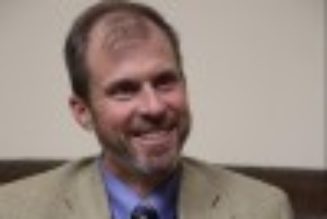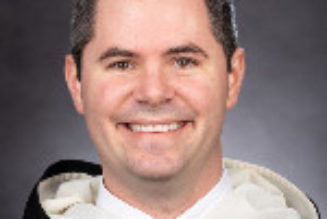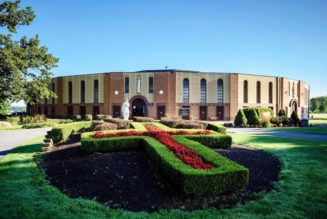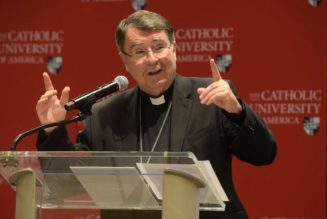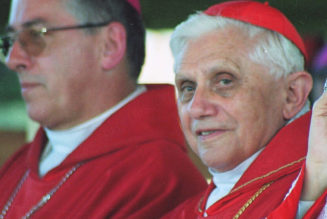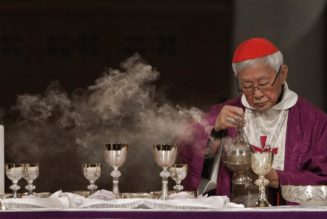
Anyone who doubts St. Augustine’s centrality to Catholic theology has to consider that (a) he is considered the greatest among the Western Fathers of the Church during the Patristic era and that (b) nobody else is as much quoted in Western theology until St. Thomas Aquinas comes around in about 850 years.
Born in Tagaste (today’s Souk-Ahras in Algeria) in November 354 to a Christian mother (St. Monica) and a pagan (later convert) father (Patricius), Augustine was intelligent. Monica enrolled him as a catechumen but, when danger to his life passed, Augustine deferred receiving the sacrament. His father sent him to Carthage to be educated, but he succumbed to the blandishments of the big city, including fornication, having a son (Adeodatus, “given by God”) while there.
Exposure to philosophy switched Augustine’s focus, and this is the period he fell in with the Manichaeans, extreme dualists who treated good and evil as two equal principles of being. He would remain under their influence for about nine years before breaking with them.
Augustine then launched into a distinguished career as a teacher of grammar, a polished writer and rhetorician. But he remained restless, unconvinced that all his learning led him anywhere. St. Monica, grieved by his immoral life and the intellectual cul-de-sacs of her son, continued to pray for him.
Finally, Augustine made his way (with Monica) to Europe. It was in Milan that finally, he was converted to Christianity. He began the study of Christian doctrine and, at Easter 387, was baptized (along with Adeodatus) by St. Ambrose of Milan. For those who want to read the stirring journey of Augustine’s spiritual and intellectual sojourn, read his Confessions, here.
Eventually, Augustine made his way back to Tagaste, where he hoped to lead something of a monastic life (even composing a rule to that end). That was not to be. By popular demand, Augustine eventually relented to be ordained a priest in 391. As a priest, he put his formidable speaking skills and intellect to the refutation of heresy (Manichaeanism still stained the region). In 396 Valerius, Bishop of Hippo, ordained him coadjutor bishop, a see Augustine would hold 34 years.
As a bishop, he combined his monastic ideals with his pastoral outreach. He was also significant for his prodigious intellectual work, refuting numerous heresies. Some of the leading errors included Manicheanism, Donatism, Pelagianism and Arianism.
Manicheanism
As previously noted, Manicheanism treated good and evil as co-equal principles, almost as if there were a “good god” and an “evil god.” Pushed hard enough, you get a split world. Augustine struggled with the problem of evil all his life — both as a theoretical problem and as a practical sinner — but he formulated the resolution of this metaphysical problem that Catholics still follow. Evil is not “something” in itself. In fact, it’s the absence of something: evil is the absence of good, good that should be present but isn’t. We say nature abhors a vacuum, emptiness. So, too, does the moral order: the lack of good that should but doesn’t exist is profoundly disruptive. But it also recognizes that good and evil are not of the same level, not co-equal “options.”
Donatism
North Africa was a leading center of early Christianity, which meant it was also a leading venue of persecution. By Augustine’s day, that era had passed: Constantine legalized Christianity under the Edict of Milan in 313. But like evil, even though it’s non-being it still leaves marks. One of those marks was what to do with apostates, i.e., those who had been baptized Christians but, under pressure of persecution, denied their faith. Many Christians had been martyred, so no one wanted to give apostates a pass.
On the other hand, some of those apostates were priests or bishops. Since the powers (as opposed to the jurisdiction) of ordination cannot be taken away, would sacraments celebrated by such apostate clergy be valid? Questions would pose a huge problem, for how could one ever know — then or now — if the minister of a sacrament is sufficiently worthy? Augustine was to distinguish the personal worthiness of a minister from the sacramental act. When celebrating a sacrament, a priest acts in persona Christi (“in the person of Christ”). As long as he does what the Church intends, i.e., properly performs the sacramental rite with proper matter and form, intending to do what the Church does (e.g., to baptize, consecrate, anoint) the sacrament occurs. His moral worthiness, while not significant vis-à-vis his own salvation, does not “cancel” or impede God’s work in the sacrament.
Pelagianism
One of Augustine’s main contributions was better developing the theology of original sin, particularly understood as an injury which — apart from redemption by Jesus — makes us incapable of doing spiritually meritorious acts. (Why? Because such acts require charity, and we who are wounded by original sin lack that innate supernatural charity, which God restored through Christ and applies to us through the sacraments, starting with Baptism.) Pelagius claimed that original sin did not affect human nature. It was, at best, a “bad example” that — as with all bad examples — makes it harder for us to do the right thing but, with enough gumption, we can nevertheless overcome bad example and do good.
Augustine, the “doctor of grace,” recognized the core heresy in Pelagianism: if that is true, man could save himself without Jesus. He simply needed to pull himself up by his own spiritual bootstraps. It is Augustine who makes clear that, whatever good fallen man does, whatever concrete good each of us does, always begins with the impulse of God’s grace, which also supports and sustains our willingness to cooperate with that grace, so that “the good God has begun in us is now brought to completion.” Augustine makes clear our salvation and our good deeds all always begin, are supported by, and end in God’s grace.
(So what do we do? We don’t block him. We pay our widow’s mite by joining our will — which God also inspires — to his. That doesn’t mean God’s grace cancels our freedom. A Russian Orthodox theologian, Theophan the Recluse, gave a good analogy: God is like an alarm clock. He rings and wakes you up. He makes it possible for you to start a new day. But you have to get out of bed.)
Arianism
Though condemned at the Councils of Nicaea and Constantinople, the Arian heresy proved difficult to stamp out. Arianism held that Jesus was not true God and true man, but something in-between, a kind of hybrid creature. It was taking some of its last gasps in Augustine’s day, and he vigorously fought it.
Augustine’s output was voluminous. Those who might want to continue reading Augustine should also look to his City of God.
The saint died Aug. 28, 430, aged 76 years.
Painting
The Flemish Baroque painter Philippe de Champaigne (1602-1674) depicted St. Augustine in oil, painted sometime between approximately 1645-50. We met Philippe’s nephew and pupil, Jean Baptiste de Champaigne (1631-1681), two weeks ago when we examined his “Martyrdom of St. Lawrence.”
St. Augustine is the central figure in Philippe de Champaigne’s painting. He sits, in richly embroidered episcopal regalia, at his well-decorated writing desk. The vestments, brocade on the desk, and Augustine’s own figure provide brightness amidst the characteristic Baroque contrasts of light and shadow. Books lie on, next to, and opposite the desk. (One detects a certain anachronism: Did that book format exist in de Champaigne’s 17th-century Flanders rather than in Augustine’s 5th-century Hippo?) Augustine holds a quill in his right hand, indicating he is the author of many of those works and pointing to his role as a Father and Doctor of the Church.
The most important light in this picture, however, proceeds in a diagonal from the upper left to the lower right and right through Augustine’s head. To Augustine’s right God reveals himself in the brightness of “Veritas” (Truth — “I Am the Way, the Truth, and the Life” — John 14:6). That light of truth, towards which Augustine gazes, passes through his head (showing us a halo), illumining his mind, and connects to a flaming heart. While devotion to the Sacred Heart was emerging in 17th-century Europe, I take the image rather as referring to one of Augustine’s most famous sayings. “You have made us for yourself, O Lord. Our hearts are restless until they rest in you.” And, as a preacher, Augustine certainly spoke to minds and hearts. (The heart, enflamed or pierced by arrows, is a frequent attribute of St. Augustine.)
Augustine’s heart (and mind) were certainly restless for Truth, even when they took many detours on that path. Yet Augustine remained committed to that end and it was God who brought Monica’s boy home. De Champaigne also captures an important insight for the work of theology: it is not just an intellectual head trip but the work of the whole person in love with God.
(For more information on St. Augustine, see here, here, here and here.)

